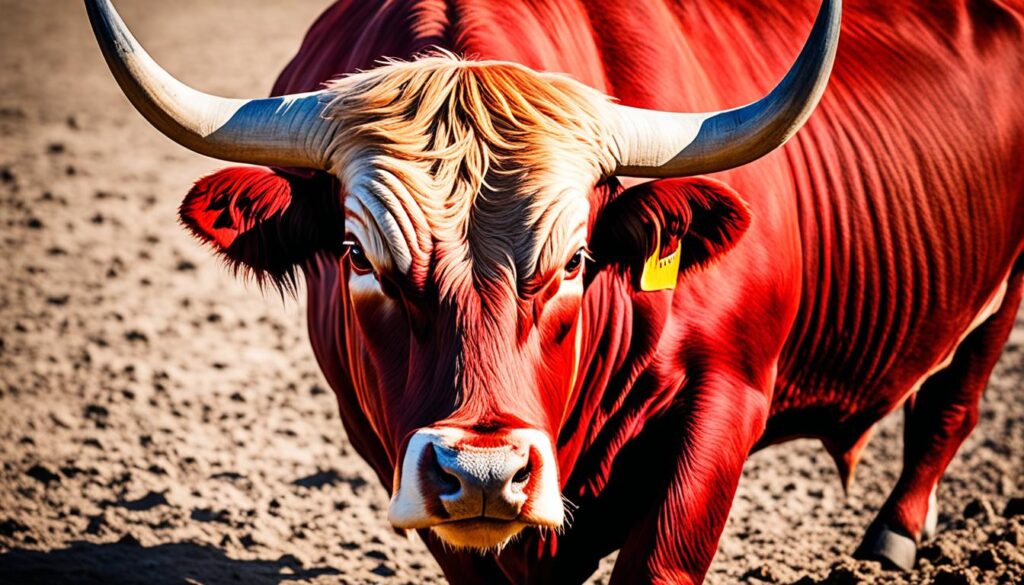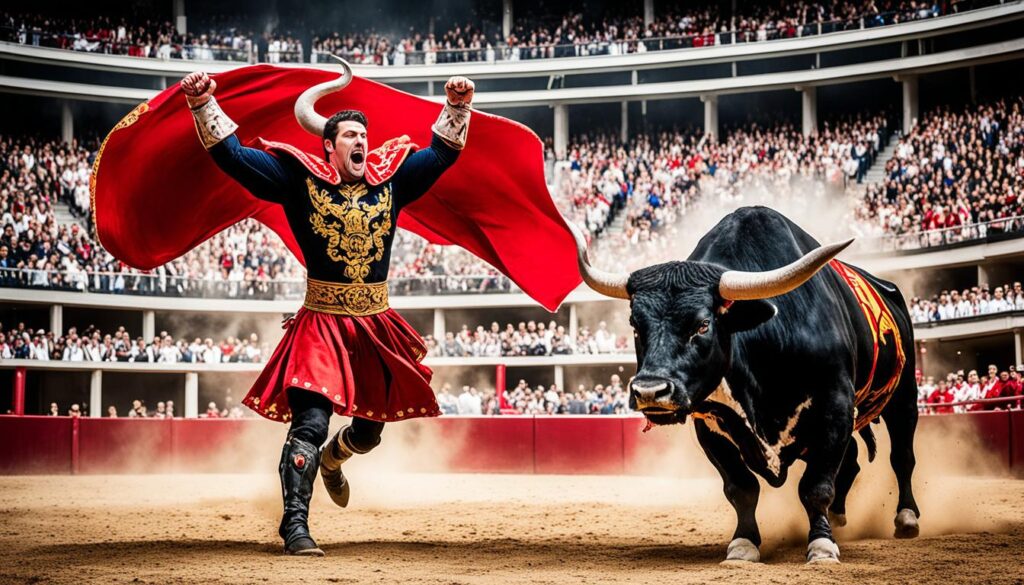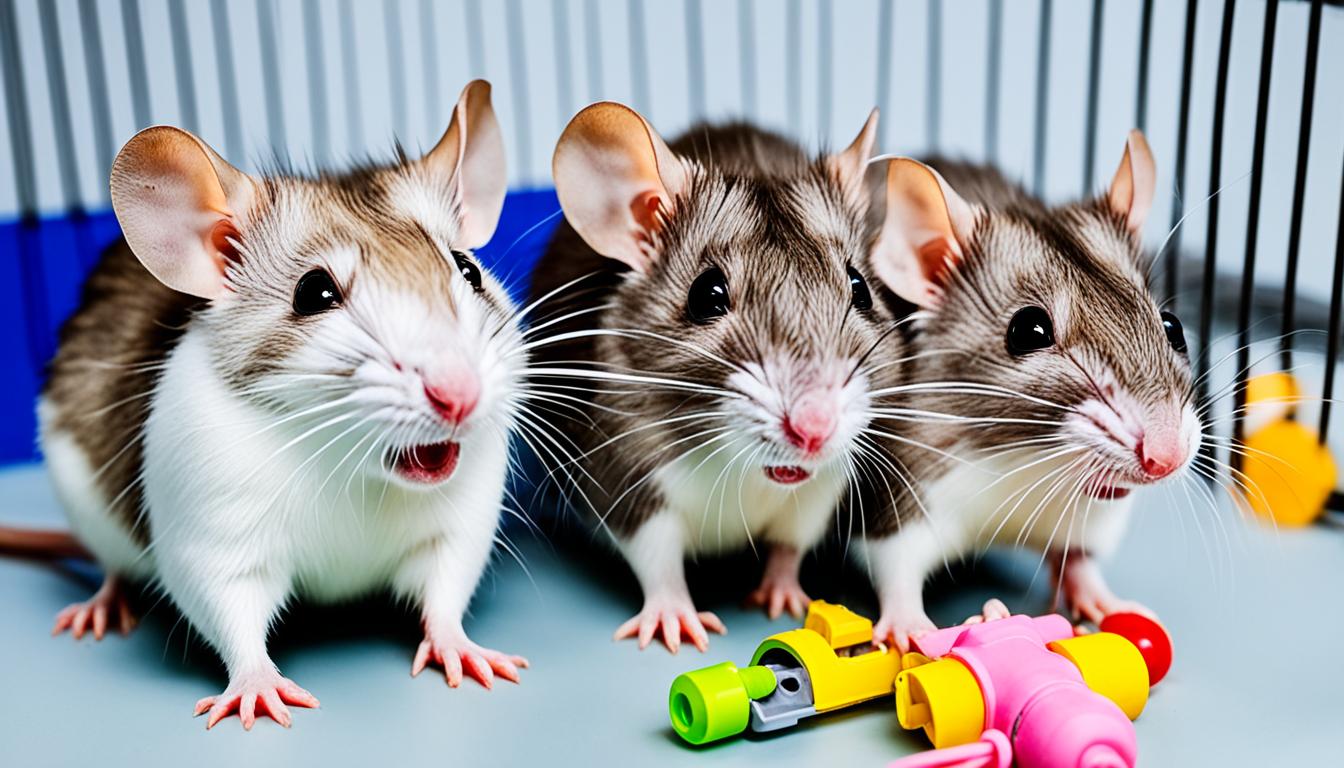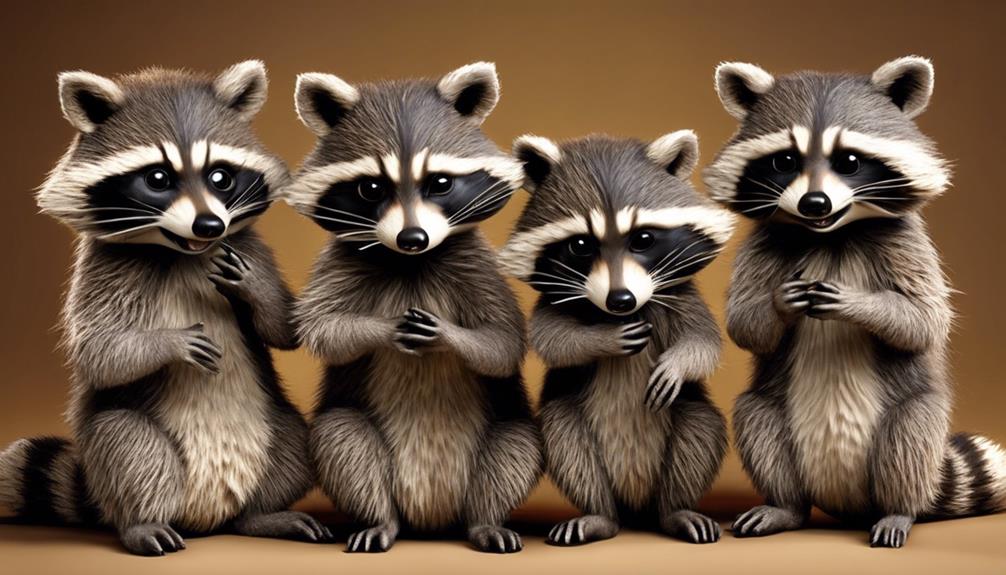Were you aware that bulls are commonly linked to anger and aggression? Despite this common belief, there is a prevalent myth that suggests bulls despise the color red and react violently when exposed to it. But is this myth actually accurate? Let’s explore further and reveal the reality behind bull behavior.
Key Takeaways:
- Bulls are colorblind to red and can only perceive blue and yellow.
- The association between bulls and the color red originated from the tradition of bullfighting.
- Bulls display aggression when they feel threatened or provoked, not solely because of the color red.
- The tradition of bullfighting has perpetuated the myth and reinforced it in popular media and culture.
- As society evolves, there is a growing recognition of ethical concerns and a shift towards promoting animal welfare.
The Truth About Bulls and the Color Red
Bulls, like many other animals, are dichromats, meaning they can only perceive blue and yellow colors. In fact, they are colorblind to red. To a bull, the color red appears as a shade of gray. This busts the common myth that bulls become enraged when they see the color red.
The association between bulls and the color red actually originated from the tradition of bullfighting. The matadors use a red cape, known as a muleta, to provoke the bull during the fight. However, it’s not the color itself that angers the bull; it’s the movement of the cape. Bulls are more sensitive to movement rather than colors. The waving and fluttering of the cape stimulates the bull’s natural instinct to charge and attack.
It’s important to understand that bull behavior is not solely influenced by the color red. This misconception often leads to misunderstandings and misrepresentations of bulls as inherently aggressive creatures. In reality, bulls are peaceful animals that spend their days grazing and enjoying a relaxed lifestyle in their natural environments.
The use of a red cape in bullfighting is primarily for dramatic effect, adding visual impact and excitement to the performance. The tradition of using a red cape to taunt the bull has become deeply ingrained in bullfighting culture and popularized through media and art. However, it’s essential to differentiate between the theatrical aspects of bullfighting and the true behavior of bulls in their natural surroundings.
“Bulls are colorblind to red and are more responsive to movement.”
By dispelling the myth that bulls hate the color red, we gain a clearer understanding of bull behavior and can approach the topic with a more informed perspective. It’s crucial to acknowledge that bulls’ responses to stimuli are more influenced by movement, proximity, and environmental factors rather than individual color preferences. This knowledge allows us to promote a greater respect and appreciation for these majestic creatures.

Now that we have uncovered the truth behind the association between bulls and the color red, let’s delve deeper into understanding bull behavior and their natural environment. Section 3 will provide insights into the factors that influence bull aggression, temperament, and social dynamics.
Understanding Bull Behavior
Bulls are inherently peaceful creatures and spend their days grazing and enjoying a relaxed lifestyle. They only display aggressive behavior when they feel threatened or provoked. In their natural environment, bulls are more influenced by social dynamics and environmental stimuli rather than individual preferences or color. They may perceive a threat based on movement, proximity, or territorial defense, not the color of the perceived threat.
Contrary to popular belief, bull aggression is not solely triggered by the color of an object or person. Bulls are colorblind to red and are more responsive to movement and proximity. The association between bulls and the color red, often seen in bullfighting, is more about the dramatic effect and visual spectacle it creates, rather than the bull’s reaction to the color itself. The use of a red cape adds intensity and excitement to the performance, making it a symbolic element of the tradition. However, it is important to distinguish between the theatrical aspects of bullfighting and the natural behavior of bulls in their native environments.
Understanding the natural behavior and temperament of bulls is crucial for their welfare and our own safety. By debunking the myth of their supposed anger towards the color red, we gain a deeper appreciation for these majestic animals and provide a more informed and respectful approach to their care.

The Role of Bullfighting in Perpetuating the Red Myth
The tradition of bullfighting has had a profound impact on perpetuating the myth that bulls despise the color red. While many believe that it is the color that triggers the bull’s anger, the reality is quite different. In fact, the use of a red cape, known as a muleta, in bullfighting serves primarily for dramatic effect and visual spectacle, rather than for any specific reaction from the bull.
The red cape has become an iconic symbol of bullfighting, deeply ingrained in popular media and culture. It evokes a sense of danger, excitement, and intense passion associated with the sport. However, it is essential to distinguish between the performance of bullfighting and the natural behavior of bulls in their native environments.
While the sight of a red cape may be aesthetically pleasing and captivating to an audience, it is not the color that incites the bull’s aggression. Bulls are dichromats and cannot see the color red as humans do. To them, red appears as a shade of gray. Instead, bulls are highly responsive to movement, proximity, and other environmental stimuli in their natural habitat.

The cultural influence of bullfighting has further perpetuated the red myth. This centuries-old tradition has become an integral part of certain cultures, deeply rooted in their history and heritage. It is celebrated as an art form, showcasing the bravery and skill of the matador in their dramatic encounters with the bull.
Bullfighting is not solely about the color red, but rather a complex cultural phenomenon that encompasses rituals, symbols, and societal values.
However, as we continue to evolve our understanding of animal welfare and ethical considerations, bullfighting has faced increasing criticism. There have been calls for bans and restrictions on this practice, reflecting a shifting perspective among individuals and societies. Advocates for animal rights argue that the use of animals for entertainment purposes, such as bullfighting, is ethically questionable and should be reevaluated.
By delving deeper into the intricacies of the bullfighting tradition, we can gain a more nuanced understanding of its cultural significance. It is crucial to separate the symbolism and spectacle associated with bullfighting from the natural behavior and needs of animals like bulls. This knowledge allows us to approach animal welfare and cultural practices with empathy, informed by scientific insights and ethical frameworks.
Shifting Perspectives and Ethical Considerations
As societal attitudes towards animal welfare evolve, there is a growing recognition of the ethical concerns surrounding bullfighting and the use of animals for entertainment purposes. The welfare of animals is becoming an increasingly important consideration in our society, and the treatment of bulls in bullfighting is no exception.
Public awareness campaigns and education about animal behavior have played a crucial role in raising awareness about the ethical implications of bullfighting. These initiatives aim to dispel myths surrounding bull behavior and promote a greater understanding and respect for animals’ natural behaviors.
One of the significant shifts in public opinion regarding bullfighting has led to bans or restrictions on this practice in several regions and countries. These bans reflect the changing attitudes towards animal welfare and the recognition of the unnecessary harm inflicted upon bulls in the name of entertainment.
“Animal welfare is of paramount importance, and it is our responsibility to ensure that animals are treated with compassion and respect. Bullfighting goes against these principles and perpetuates practices that harm these majestic animals.”
– Animal Rights Activist, Jane Roberts
By outlawing bullfighting, communities and governments are taking a stand for animal welfare, recognizing that the use of animals for entertainment purposes is no longer acceptable in modern society. These bans not only protect the bulls but also send a clear message that animal cruelty will not be tolerated.
The Power of Public Awareness
Public awareness plays a crucial role in driving change and promoting animal welfare. By engaging and educating the public about the realities of bullfighting, we can shift public opinion and gradually eliminate the practice altogether.
Education initiatives that highlight the behavioral characteristics of bulls, their natural environment, and their peaceful nature can dispel the myth that they are inherently aggressive or have an aversion to the color red. These campaigns aim to create a better understanding of bull behavior and foster empathy towards these magnificent animals.

Conclusion
Contrary to popular belief, bulls do not hate the color red, and their aggression is not solely triggered by the color itself. Bulls are colorblind to red and are more responsive to movement and proximity. The association between bulls and the color red originated from the tradition of bullfighting, where the use of a red cape adds drama and visual impact to the performance. It is important to distinguish between the theatrical aspects of bullfighting and the natural behavior of bulls in their natural environments.
By debunking these myths, we gain a deeper understanding of bull behavior and promote a more informed and respectful approach to animal welfare. Bulls are inherently peaceful creatures that spend their days grazing and enjoying a relaxed lifestyle. They only display aggressive behavior when they feel threatened or provoked. It is crucial to consider the social dynamics and environmental stimuli that influence their behavior rather than attributing it solely to individual preferences or the color of perceived threats.
As societal attitudes towards animal welfare continue to evolve, there is a rising awareness of the ethical concerns surrounding bullfighting and the use of animals for entertainment purposes. Some regions and countries have implemented bans or restrictions on bullfighting, reflecting a shift in public opinion. Public awareness campaigns and education about animal behavior aim to dispel myths and promote a greater understanding and respect for animals’ natural behaviors. By understanding bull behavior and debunking these myths, we can contribute to a more compassionate and responsible approach to our interactions with these magnificent creatures.










